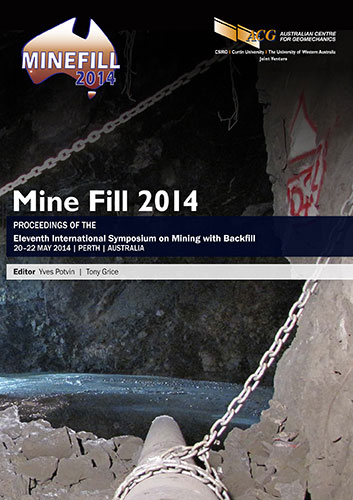A critical look at uniaxial test procedures applied in the backfill industry

|
Authors: Snyman, BJ; van der Spuy, B; Correia, LDC |
DOI https://doi.org/10.36487/ACG_rep/1404_11_Snyman
Cite As:
Snyman, BJ, van der Spuy, B & Correia, LDC 2014, 'A critical look at uniaxial test procedures applied in the backfill industry', in Y Potvin & T Grice (eds), Mine Fill 2014: Proceedings of the Eleventh International Symposium on Mining with Backfill, Australian Centre for Geomechanics, Perth, pp. 161-173, https://doi.org/10.36487/ACG_rep/1404_11_Snyman
Abstract:
Uniaxial/unconfined compressive (UCS) strength testing and triaxial testing are two of the most commonly used test procedures to assess the shear strength of backfill today. Some of the backfill test procedures currently in use were originally developed by other engineering disciplines and modified to meet the requirements of the mining industry. For example, UCS tests are performed by geotechnical, concrete and rock engineers. When using procedures developed for other engineering disciplines it is important to think critically about the intended purpose behind specifications and requirements and the applicability of these related to backfill. This paper compares the most commonly used UCS test procedures. The paper will then investigate the effect of the most important parameters influencing test results, such as specimen shape, size and aspect ratios, by presenting laboratory test results for a specifically designed test campaign. A graphical model is presented demonstrating the relationship between strength, water content and parameters influencing backfill pumpability.
References:
ASTM International 2000a, ASTM D1633 Standard Test Methods for Compressive Strength of Molded Soil-Cement Cylinders, ASTM International, West Conshohocken.
ASTM International 2000b, ASTM D2166Standard Test Method for Unconfined Compressive Strength of Cohesive Soil, ASTM International, West Conshohocken.
ASTM International 2002, ASTM D4832Standard Test Method for Preparation and Testing of Controlled Low Strength Material (CLSM) Test Cylinders, ASTM International, West Conshohocken.
Bieniawski, ZT, Franklin, JA, Bernede, MJ, Duffaut, P, Rummel, F, Horibe, T, Broch, E, Rodrigues, E, van Heerden, WL, Vogler, UW, Hansagi, I, Szlavin, J, Brady, BT, Deere, DU, Hawkes, I & Milovanovic, D 2007, Suggested methods for determining the uniaxial compressive strength and deformability of rock materials, The complete ISRM suggested methods for rock characterization, testing and monitoring: 1974-2006, ISRM Turkish National Group, Ankara, Ankara Province.
Gongkang, F & Elwell, DJ 1995, Compression Testing of Concrete: Cylinders vs. Cubes, special report 119, New York State Department of Transportation, New York.
Head, KH & Epps, RJ 2011, Manual of soil laboratory testing Volume 2: Permeability, shear strength and compressibility tests, Whittles Publishing, Dunbeath, Caithness.
The South African Bureau of Standards 2006a, SANS 5860:2006Concrete Tests – Dimensions, Tolerances and Uses of Cast Test Specimens, The South African Bureau of Standards, Pretoria.
The South African Bureau of Standards 2006b, SANS 5861-3:2006Concrete tests – Making and curing of test specimens, The South African Bureau of Standards, Pretoria.
The South African Bureau of Standards 2006c, SANS 5863:2006Concrete tests – Compressive strength of hardened concrete, The South African Bureau of Standards, Pretoria.
© Copyright 2025, Australian Centre for Geomechanics (ACG), The University of Western Australia. All rights reserved.
View copyright/legal information
Please direct any queries or error reports to repository-acg@uwa.edu.au
View copyright/legal information
Please direct any queries or error reports to repository-acg@uwa.edu.au